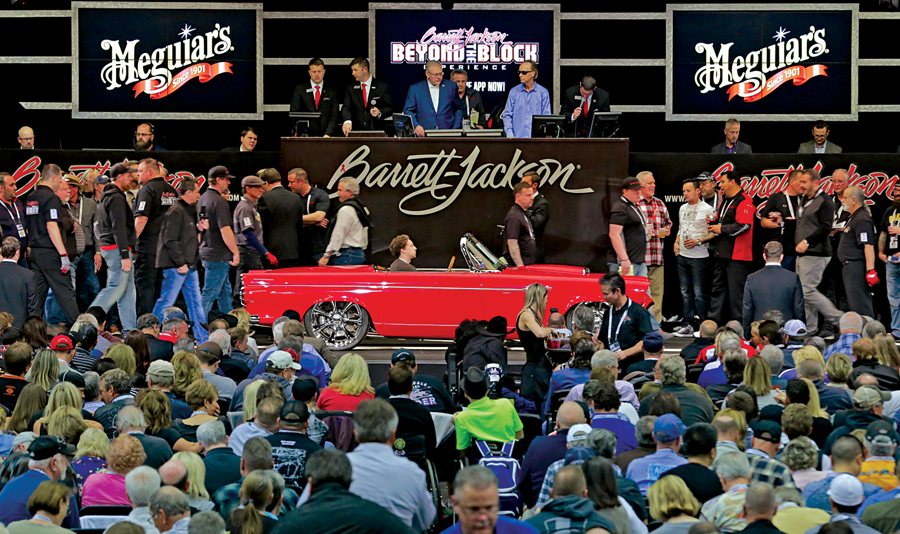
The process of writing for and contributing to the publication of a magazine can, at times, feel a bit like a long, lonely, one-way conversation. We report, we analyze, we predict, and we assess — all in an effort to create content that we hope you find engaging, thought-provoking and relevant in ways that are both entertaining and insightful.
There are times, however, when I just can’t help but wonder where all those words land once they’re shot out into the ether.
That’s why when Editor Pickering invited me to participate in this year’s ACC writer’s panel at Barrett-Jackson’s Scottsdale sale, I jumped at the opportunity to join him, Carl Bomstead, B. Mitchell Carlson and Sam Stockham in front of a living, breathing audience. Pickering asked each of us to reflect on the current market and then choose two vehicles to buy, two to sell and two to hold. The forum would then be an opportunity for each of us to dive into the specific rationale for our choices, as well as a chance for a little back-and-forth banter where our opinions failed to align. Never one to shy away from a good argument, I couldn’t pass up the invitation.
Two to buy, sell and hold
Now, you might expect that a panel with birthdates and personal expertise as widely varied as ours would have much to argue, but, in truth, there was very little to disagree about. I’ve been known to go toe-to-toe with a fencepost or two in my time, but even I found myself nodding my head and appreciating the commentary.
Among the five of us, we’ve contributed to hundreds of pieces of content for ACC, ranging from profiles to market reports to columns and everything in between. As a result, I don’t think any of us were all that surprised by each other’s picks to buy, sell and hold, but that wasn’t the interesting part of our discussion. Where things turned on their head, for me anyway, was when it came time for each of us to divulge our personal vehicle of choice off the sale’s docket.
The smart thing to do would have been to support our arguments by following our own advice, but that’s not what happened. None of us, aside from Pickering, who is supposed to be the voice of reason in this crowd, chose vehicles from the “Buy” category we had just spent an hour advocating to our live audience. Hell, Bomstead didn’t even pick an American car.
In fairness, Carl was the only one of us who, when asked to pick one car, actually picked one car, so he at least gets credit for following directions.
Sam picked a kit-car, one that he readily admitted was little more than a dashingly visceral cash-disposal machine, and a 1977 Pontiac Can Am. You read that right — a 1977 Pontiac. Why? Because, according to him, it was too ugly to pass up.
B. Mitchell chose a 2017 Ford GT, a 1940 International pickup, and a 1972 Chevy Blazer — the latter only because it was a dead ringer for the one his neighbor had when he was young.
As for me, well, my picks weren’t much better. Both Jim and Sam selected first-gen Thunderbirds for their “Sell” category, and I agreed fully, mostly because I don’t like Thunderbirds. But that didn’t stop me from picking an extensively modified Ridler-award-winning ’55 that hid not a single minute of the thousands of hours that went into its making.
My other favorite? An ’84 K-10 long-bed shined up as the spittin’ image of Lee Majors’ berm-jumping, bad-guy-wrecking man-mobile from the ’80s TV show “The Fall Guy.” Brilliant, huh? As it turned out, both are profiled in this issue on pages 58 and 64, respectively.
Buying on emotion
So what exactly is the common thread here? We all unapologetically chose vehicles that spoke to us in some very personal way, common sense be damned. It’s one thing to know the smart play, but another thing entirely to act on it. Was this a quintessential case of “Do as I say, not as I do”? Not exactly.
Although American collector cars are analyzed and scatter-plotted and bar-graphed as an investment-grade market, we’re not dealing with stocks and bonds here. To deny the inevitability of irrational and emotionally charged decision making in this market is to deny the true purpose that draws thousands upon thousands of consignors, bidders and spectators out into the middle of the desert every January — we are enthusiasts first and foremost.
Buying and selling old cars for the sole purpose of turning a profit can be a risky undertaking for even the savviest of market hawks, which is exactly why ACC’s contributors work so hard to deliver up-to-the-minute information in the form of indisputable fact. We record the sales and crunch the numbers and log the data so that you can make informed decisions to maximize your profit and minimize your risk, if, you know, you’re into that kind of thing. But those numbers, while vitally important, can’t ever tell the whole story.
Once our panel adjourned, Sam, Jim and I spent an hour or two cruising the grounds to decompress and get some fresh air. We made our way up and down the rows of outdoor lots, trying to cover as much ground as possible before responsibilities pulled each of us in different directions.
The first of our collective picks that we stumbled across was Sam’s ’77 Can Am. As we nit-picked and circled, inspected the shaker and measured the doors (this big!), the smile on Sam’s face told the story that won’t be published.
As for the buyer, we may need to track him down. Lot 425 sold for just $26,400, including buyer’s premium.